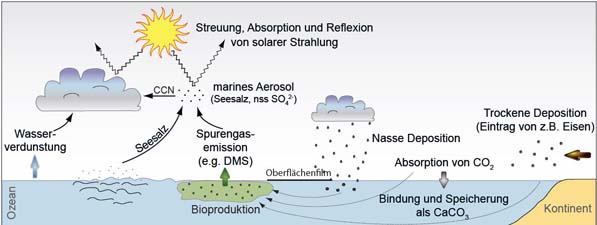
Picture caption: Interaction between ocean and atmosphere leading to the formation of ma-rine aerosol

Marine aerosol - tiny suspended particles above the sea - can influence the Earth's radiation budget directly and indirectly through absorption and reflection of incident solar radiation. Marine aerosol particles can be formed in various ways, for example through interactions between the ocean and the atmosphere, and can change as a result of their environmental conditions. Important processes in the formation of marine aerosols are, on the one hand, the so-called "bubble bursting", whereby bursting air bubbles at the sea surface introduce compounds from the sea water directly into the atmosphere. Furthermore, the emission of volatile compounds from the oceans plays an important role in aerosol formation.

Picture caption: Interaction between ocean and atmosphere leading to the formation of ma-rine aerosol
In order to better understand the sources, transport and formation pathways of marine aerosols and to assess the importance of marine particles for global climate observation, it is necessary to know their chemical composition as well as their microphysical and optical properties. Besides sea salt, marine aerosols contain a large proportion of organic compounds that significantly influence aerosol properties. In addition to marine aerosols, seawater is also studied as an important source of these compounds. With regard to seawater, the chemical composition of the surface film of the oceans is of particular interest - a micrometre-thick layer that represents the direct interface between seawater and the atmosphere and is often enriched with organic compounds.
The glass plate technique is used to sample the surface film of the oceans. This involves a thin glass plate is placed vertically in the water and slowly removed. The micrometre-thick surface film adheres to the glass surface and is wiped off with a Teflon wiper. The samples collected in this way are immediately deep-frozen and transported with refrigerated containers and dry ice to the TROPOS laboratories, where chemical analysis takes place. The identification and quantification of the climate-relevant organics in particular is carried out using complex chemical analysis methods. Coupled chromatographic and mass spectrometric systems are used.
The manifold interactions between ocean and atmosphere are being investigated in various projects in order to better understand the sources, processes and formation pathways of marine aero-sol particles. In particular, the role of the marine surface film (SML) as an interface between ocean and atmosphere is being investigated in more detail. Extensive field campaigns are taking place in the tropical Atlantic and in the Polar Regions. TROPOS ACD led the MarParCloud campaign at CVAO (2017), participated in the PASCAL/SIPCA campaign (2017) and in the MOSAiC Drift (2019-2020) in the central Arctic, and participated in the PI-ICE campaign (2019) (link to Research in Polar Regions) on the western Antarctic Peninsula.
Recent Publications since 2019 (Lead: ACD):